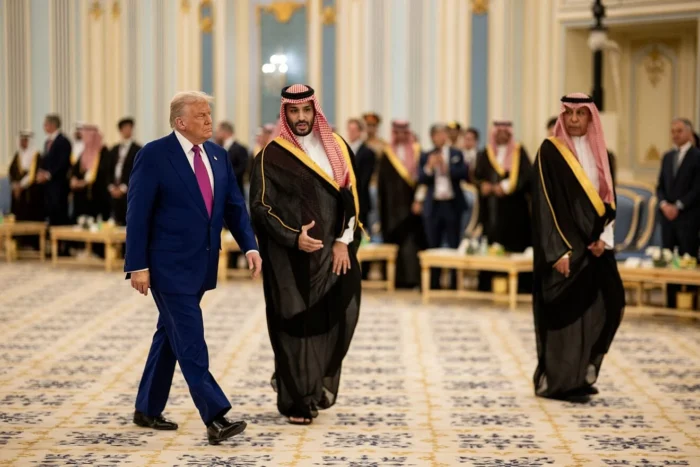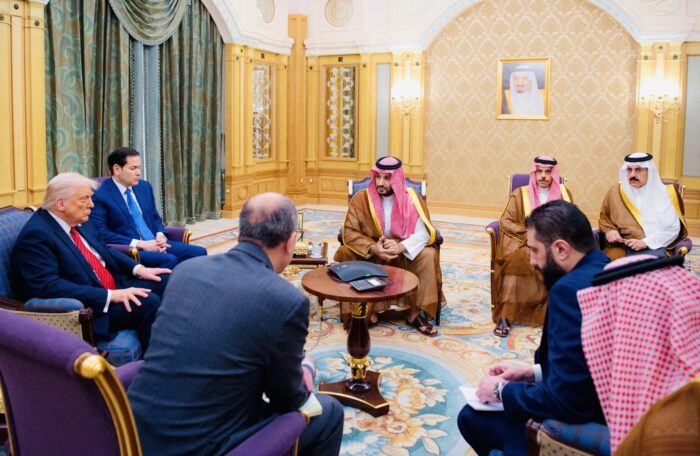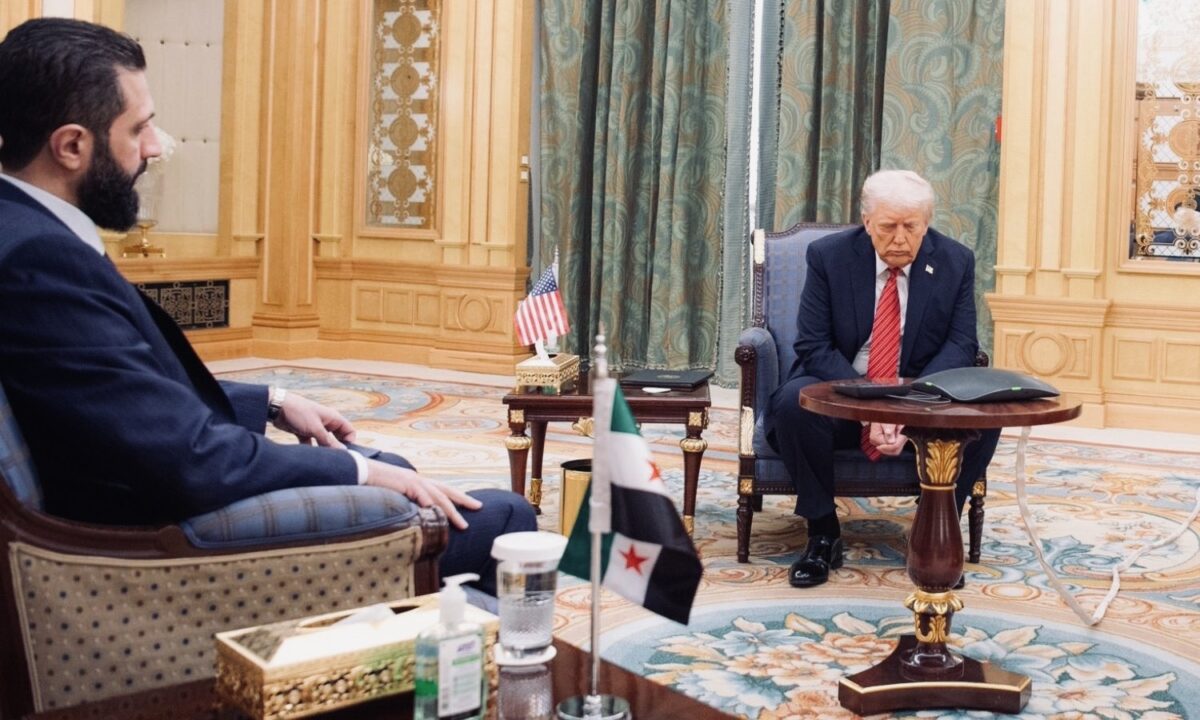It was a stunning and defining moment in the annals of the United States’ mercurial relationship with Syria.
On May 13, U.S. President Donald Trump announced a plan to lift all economic sanctions on Syria, a formerly radical Arab state that is still emerging from the chaos of the sudden collapse of President Bashar al-Assad’s dictatorial regime last December.
“I am ordering the cessation of sanctions against Syria to give them a fresh start,” he said at a conference in Saudi Arabia of the Gulf Cooperation Council. “It gives them a chance for greatness. The sanctions were really crippling, very powerful.”
The end of U.S. sanctions is no small matter. It will boost Syria’s battered economy and facilitate its reintegration into the international economic system.
Shortly after his announcement, Trump met Assad’s successor, Ahmed al-Shara, the interim Syrian president, for about 30 minutes. He used such words as “young, attractive, tough and strong” to characterize Shara.
Trump said he agreed to talk to him at the request of two regional allies, Saudi Arabia’s crown prince and de facto ruler, Mohammed bin Salman, and Turkish President Recep Tayyip Erdogan.

Trump was the fourth American president to confer with his Syrian counterpart. He was preceded by Richard Nixon, Jimmy Carter and Bill Clinton, who met Assad’s father, Hafez al-Assad, in 1974, 1977 and 2000 respectively.
Commenting on his brief encounter with Shara, Trump said he thought Shara had a “real shot at holding it (Syria) together.”
On the eve of his meeting, Trump said, “There is a new government in Syria that will, hopefully, succeed in stabilizing the country and keeping the peace. That’s what we want to see in Syria.”
Trump disclosed that Shara had agreed to eventually join the 2020 Abraham accords, under which United Arab Emirates, Bahrain, Morocco and Sudan normalized relations with Israel.
A White House spokesperson told reporters that Trump had urged Shara to “deport Palestinian terrorists,” join the battle against the Islamic State organization, and dispose of the rest of its chemical weapons.

Two days later, U.S. Secretary of State Marco Rubio met Syria’s foreign minister, Asaad Hassan al-Shaibani, in Antalya, Turkey, to discuss when sanctions will be lifted. The timeline remains unclear at the moment. Rubio said that the United States’ objective is to help establish a stable and peaceful Syria.
The lifting of sanctions was the culmination of a diplomatic campaign by the current Syrian government to reduce its economic woes and ease its international isolation.
Syria had apparently informed the Trump administration of its willingness to grant the U.S. concessions — commercial access to Syrian oil fields and assurances that Israel’s security will be respected — in exchange for the elimination of sanctions.
The Syrian foreign minister hailed the planned removal of sanctions as “a new beginning on the path to reconstruction” after 12 years of civil war.
Shara, in an interview with The New York Times, said the sanctions were originally imposed on Syria as “a response to crimes committed by the previous regime against the people.”
The U.S. imposed sanctions on Syria, Iran’s chief ally in the Arab world until last year, in the late 1970s after accusing it of being a state sponsor of terrorism. Syria was slapped with yet more U.S. sanctions after its bloody crackdown on peaceful protesters in 2011. The violence triggered a protracted civil war that only ended with Assad’s fall.
During the first years of the war, which resulted in the deaths of hundreds of thousands of Syrians and the displacement of millions, the U.S. funnelled weapons and munitions to Syrian rebels seeking Assad’s overthrow. In 2012, Washington severed diplomatic relations with Syria.
Since Syria’s independence from France in 1946, Syria has had a tense, roller-coaster relationship with the U.S. In the wake of the 1967 Six Day War, Syria formally broke diplomatic relations with the U.S., citing its support of Israel.
During this period, Syria formed close strategic ties with the Soviet Union and its successor state, Russia. In addition, Syria provided financial, military and political assistance to Hamas and Hezbollah, two of Israel’s primary enemies.
That Trump and Shara met is a testament to changing times.
Shara, a former jihadist who battled U.S. forces in Iraq from 2003 onward, had a $10 million U.S. bounty on his head until 2024. Trump’s predecessor, Joe Biden, cancelled it last December. And this past January, the outgoing Biden administration lifted some restrictions on humanitarian aid to Syria.
Shara, born in Saudi Arabia to Syrian exiles, joined Islamic State during the U.S. occupation of Iraq. He survived numerous American and British air raids and special forces operations. Breaking away from Islamic State, he established the Al-Nusra Front, a branch of Al-Qaeda. He then created Hayat Tahrir al-Sham (HTS).
With the destruction of Islamic State’s caliphate in Iraq, Shara built an HTS enclave in Syria’s northwestern Idlib province, near Turkey. The Turkish government backed HTS and its lightning offensive against Assad’s regime, which collapsed like a house of cards on December 8, 2024.
Since then, Shara has attempted to mould an image as a moderate. In pursuit of this goal, he has formed an inclusive government and promised to respect the rights of minorities and women within a pluralistic society.
Barbara Leaf, the former U.S. Secretary of State for Near Eastern affairs, met Shara last December and thought he was a pragmatist.
Nonetheless, ethnic tensions have spilled over in Syria. Two months ago, two minority groups, the Alawites and the Druze, were attacked by Sunni Muslim gangs affiliated with the previous regime, tarnishing Shara’s reputation.
Trump, in his perception of Syria, has come a long way, too.
Prior to assuming his second term of office, he branded Syria as a nation of “sand and death,” called it “a mess” and said the U.S. “should have nothing to do with it.”
During his first term, Trump ordered two separate air strikes on Assad’s forces as punishment for using chemical weapons against rebel fighters.
He vowed withdraw all U.S. troops from Syria, but changed his mind after being convinced that an American military presence in Syria was a check on Iranian influence, which has greatly diminished since Assad’s downfall.
Last month, however, the Trump administration began pulling some U.S. soldiers out of Syria and closing three bases in its northeast corner.
Trump is expected to leave about 1,400 troops in Syria to fight the remnants of Islamic State.
Israel, which is suspicious of Shara and has condemned him as a jihadist in a suit, has warned the U.S. not to rush into recognizing the new government in Syria. A few months ago, the Reuters news agency reported, Israel lobbied the U.S. to keep Syria decentralized and isolated.
Judging by Trump’s actions, he is likely to disregard Israel’s advice.
In the meantime, Israeli military operations in southern Syria have persisted, with Israel having carried out dozens of air strikes in recent months to take out Syrian military assets.
Working on the assumption that Syrian territory could be used as a platform from which to attack Israeli settlements in the Galilee and the Golan Heights, Israel has said it will not allow Syrian government forces to deploy in the south.
